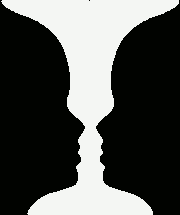This month’s topic is “Reason”, perhaps the congnitive power that most differentiates the human animal from the rest of the species on the globe. If there’s one thing that people do which other animals fail to do, one thing that differentiates and transcends us most from the animal horde, it’s the human being’s power of reason.
Oh, sure, other animals do some amount of reasoning. A crow may figure out that it can bend a wire into a hook to retrieve something from deep within a glass, a chimp may use the powers of reason to tempt termites from their home to use them as a tasty snack, but these things are remarkable precisely because they are so rare. No animal seems to have such a good understanding of it’s environment, the way the world works, that they can as a matter of course plan and plot and build tools and devices to further their goals in quite the same way that human beings across the spectrum of intelligence do as part of their normal regular every-day existence.
The seat of reason in human beings is, it’s thought, in the prefrontal cortex. It’s this area that allows you to pause and think before you act, to plan complex cognitive behaviours, aid in decision making and orchestrate your thoughts and actions. It’s where problem solving happens, and no other species alive on the planet has one even half as big as yours. The transcendental evolutionary path human beings have taken over the few million years since we split from the rest of the primates has, in a very real sense, been one focused on extending that prefrontal cortex, enlarging it and thus giving you massively increased powers of reason. It allows you to learn from experience, and to reason about what you have learned.
Eliezer Yudkowsky descirbes reason as the utimate super power, saying that “The user of this ability contains a smaller, imperfect echo of the entire universe, enabling them to search out paths through probability to any desired future.“
When you use your powers of reason, you are experimenting in your model of the universe, this allows you to try many different approaches to solving a problem without lifting a finger, you can know without even trying which solutions may work, which certainly won’t. You can formulate a plan, devise a strategy, generally figure out how to proceed without having to rely on pre-built instincts and impulses.
Reason is truly a super-power which most of the animal kingdom lacks entirely, and only homo sapiens has really mastered.
Learning to use this super power more effectively should, we can reason, help even more.
Symbolic Nature
The “echo of the entire universe” which Eliezer mentions is, of course, not a physical universe somehow mirrored in your brain. Your mind does not manipulate real things to plot and scheme a solution to some problem. When you pull up a chair to stand on in order to reach a high shelf you haven’t manipulated an actual chair in order to devise your strategy. The echo of the universe which is held within your skull is a virtual universe, a symbolic universe. Your plan was hatched not by experimenting with a chair, but by understanding what a chair is, and how it behaves. The chair in your mind is not physical but symbolic. It’s a model of a chair.
Which brings us to the first requirement for useful reasoning: your model must be accurate. If your model of a chair indicates that stepping on it will cause it to collapse, you will not see that you are able to use it to gain the height needed to reach that shelf. If your model of a wire indicates it can’t be bent then it will not occur to you to try and fashion a hook with it. In order for reason to be at it’s most reasonable, you need to understand how things work, to have a good representation of the universe in your head, for your echo of reality to be founded in truth.
How can your mind best do this? It requires several mental skills, many of which we have already been improving:
The basic reasoning skills
Memory
In order to build a good model of a wire, or a chair, or a friend, or a political system, you must be able to remember your encounters with them. In order to hold a representation of the universe in your mind you must be able to remember it. All reasoning is based on symbols, and those symbols have to be remembered, their existence, their meaning, their functions and properties all have to be stored in the synapses of your mind somehow.
Categorisation
It’s not enough just to remember though, you must also be able to classify objects. There’s no point remembering that a chair you encountered as a child was able to support your weight and so increase your reach if that chair is back at your childhood home. You need to be able to tell that all chairs have this ability, these functions. You need to be able to assign those properties not to one specific wire or chair but to all objects in that class. Only then will your model of the universe be general enough to reason with.
Extrapolation
You need to not only be able to classify objects, but also to know which properties of those objects are common to all instances and which are specific to an individual object. You need to be able to extrapolate those properties from one instance of a class to the other examples of that class which share those properties. You need to be able to figure out which chairs are tall enough to reach that shelf, which wires are both bendy enough and solid enough to build a hook.
Analogy
When an instance of a class of things is not available, it’s useful to be able to spot things which are analogous to that class. If there are no chairs, perhaps a box will do? Or a table? The power of analogy is an incredibly important part of the reasoning process. When is one thing enough like another thing to be used for the same functions?
Some would argue that since no two events in spacetime are the same as each other, all reasoning must be by analogy. This collision of two billiard balls isn’t quite the same as that one, they’re in different places with different velocities at different times, but they’re analogous to each other. All thinking is analogy, comparing like with like, capturing what they have in common.
Logic
The language, the symbols, the model of the world in which you operate contains a thing called “Boolean logic”. You understand what is meant by the words “And”, “Or” and “Not”. These things, these logical operations, these symbolic connectors, are abstractions. They are not items, physical objects which are present in the universe for you to observe. Yet the rules of logic are undeniably a part of the world that your internal echo reflects. It really is true that if there are two people in a field, there must be at least one person in that field. It sounds trivial, it is trivial, but it’s worth noting that the world really does work that way. And so should your model of it. If your proposed solution to a problem defies logic, it will never work. You can use logic to rule out whole areas of solutions which can not possibly work. Improving your logic improves your model because the world really does operate that way.
Inference
If you observe that there is a chair available, you can infer several things about that chair by knowing what properties other things in the same class have. A chair will have a part which is higher off the ground than other parts. It will be solid enough to support your weight. Being able to infer the physical properties of an object just by knowing it’s symbol is invalueable
Stepping out of the system
These mental skills, and likely others like them, combine to allow you to represent the entire universe symbolically in the firing patterns and connections of neural cells in your brain. It is a fantastic feat. It is worth noting that the powers of reason allow us to do things that a being which only reacts reflexively, which doesn’t have such a model, cannot. To model impossible worlds.
Douglas Hofstadter, in Gödel, Escher, Bach, shows us how reasoning is about more than any of these things, it’s the combination of all of them. He says “Logic is done inside a system while reason is done outside the system by such methods as skipping steps, working backward, drawing diagrams, looking at examples, or seeing what happens if you change the rules of the system.“.
He suggests that reason is about understanding and modelling not just a world governed by logic, but logic itself. To go further even than that, and model the system which can model logic. The further up this tree of understanding and re-representing the universe you climb, the better your reason will be.
Many of the best lines of reasoning have this property, they take a step back and analyse not just the problem at hand, but the reason the problem exists, the world in which it’s formed. If you can find some way to solve whole classes of problems then this cached result can be used over and over again when other examples of the same difficulty arise. You only had to figure out how to stand on a chair once, and that result gives you a new tool for all future similar problems
The Meditation
Over the next few weeks we’ll look more deeply into some ways to practice and improve your reasoning ability. We’ll finish with a lucid dream which will encourage you to examine your reasoning abilities, to improve each of the skills mentioned above, and more, by introspection on your internal representation of the universe, the echo of the world which you experience as you dream.





